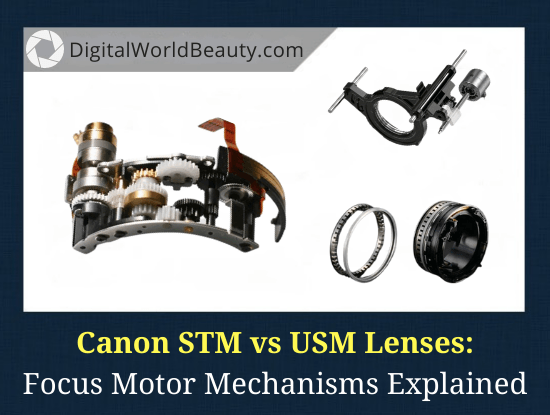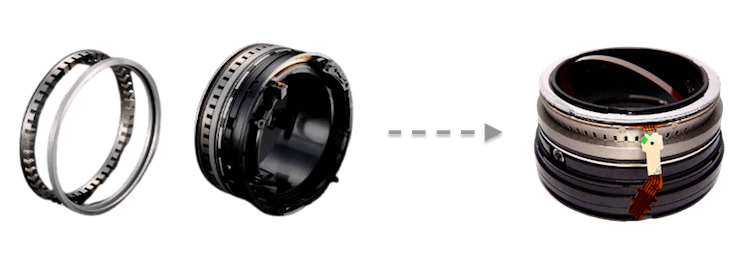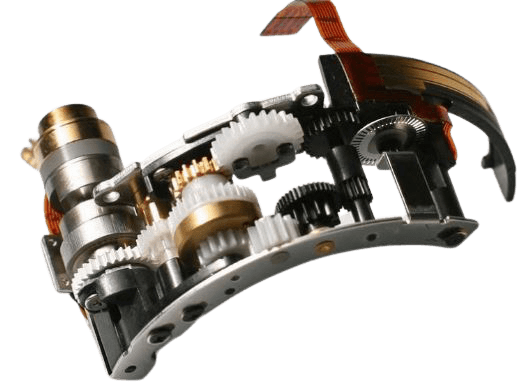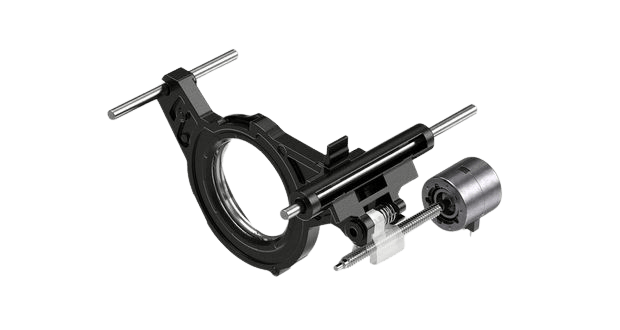Please note: As an Amazon Associate I earn from qualifying purchases. I also work with other affiliate partners and may be compensated from the links below. Details here.
Canon STM vs USM Lenses: Focusing Motor Mechanisms Explained (Ultimate Guide)

Welcome to my in-depth guide on Canon STM vs USM lenses! (With history)
Let’s face it…
Canon has a long history of innovation and truly offers a wide range of gear for every type of shooting.
Many photographers wonder what is STM lens and what is USL lens technology and, how it compares to other Canon focusing systems.
Their first lens with an in-built focusing motor was introduced back in 1987 and since then, they have continued to innovate by introducing three types of motors for modern photography:
- the STM (Stepper Motor),
- USM (UltraSonic Motor), or,
- more conventional DC type motor.
Now, what is the difference between STM and USM lens? How does each type work?
It is important that photographers are mindful about which glass suits their needs best; whether it be faster focus acquisition on fast moving subjects, silence during shooting or just easier manual control over their photos.
And that’s what I’m here to help you with today.
Canon STM vs USM: A Brief History
Canon STM lens technology is relatively new to the field of photography.
Initially introduced in 2012, STM technology provides a more-compact solution for photographers who can’t carry around large lenses that demand large amounts of space.
Canon USM lenses were first introduced to the photography market during the 1980’s, after the production of the 300mm f/2.8L USM lens (which was one of Canon’s first EF-mount lenses).
This glass was innovative but expensive for the average consumer at the time. Therefore, Canon worked to develop USM lenses that were more-easily-manufacturable and could be priced for a larger part of their customer base.
Of course, both of these are a major upgrade from the technology that camera manufacturers were initially using decades ago.
Prior to the introduction of lens-mounted autofocus systems, cameras used to provide AF by manually rotating their attached lenses with motors that sat inside of the actual camera bodies.
In efforts to optimize it, and to decrease the overall size of the system, Canon developed the now-famous EF-mount.
EF-mount cameras include electrical connectors within their lens mounts that are able to communicate with the autofocus systems of the glass that they are attached to.
Not only did the EF-mount system decrease the overall size of the AF systems that were being used, it allowed for them to be optimized for their specific lenses.
In a fast-paced field where picture quality and sharpness is crucial, having the gear that is able to focus quickly is essential.
What Is a USM Lens?
So, what does Canon USM mean?
An abbreviation for Ultra Sonic Motor, this type of glass provides much-quicker AF capabilities than the many standard ones offered by Canon.
The USM lenses are great for photography scenarios when subjects are moving rapidly and unexpectedly, like during sporting or automotive events.
Speaking of which…
The 100-400mm IS USM is one of the most renowned sports and action lenses in the Canon EF range. So if that’s your main shooting genre, I highly recommend you check this glass out.
Now, Canon currently offers four different types of USM lenses, each with its own set of advantages and disadvantages.
The most expensive models utilize a ring-type Ultra Sonic Motor. However, Micro-type, Micro II-type, and Nano-type Ultra Sonic Motors are used on the less-expensive models.
Ring-type USM glasses are typically the most expensive ones because they provide quick and crisp autofocus capabilities.
Micro-type, Micro II-type, and Nano-type USM glasses sacrifice AF speed for silence, and tend to operate more quietly than their ring-type counterparts.
So, what does USM mean on Canon lenses? Let’s talk about the focusing mechanism of these.
1) Ring Type USM

If we look at it physically, the ring-type USM is two rings.
One ring is fixed on the lens barrel; the second ring is on a group of lenses, the movement of which is necessary for focusing. The rings rotate relative to each other and thereby displace the lens for focusing.
With this design, it is quite logical to make a mechanical focus indicator drive, which also rotates.
2) Micro USM
Instead of directly connecting to the lenses, it uses a series of gears. The motor itself is quieter than the Ring USM but the gears create additional noise and reduce focusing accuracy.

Ring USM is better suited for focusing large and heavy groups of lenses, so it is used in more expensive L series lenses while Micro USM is used in cheaper amateur gear with a simpler and ‘lighter’ optical design.
USM is fast and sharp, which is important for action scenes. However, when recording video using AF, the excessive sharpness of the USM motors began to interfere, and it became necessary to make the autofocus movements smoother.
The developers were faced with the task of improving the smoothness of the AF, while reducing the cost of production and mass-dimensional characteristics.
The solution to the problem was the development of the STM. For those wondering what does STM mean in photography terms, it refers to this Stepping Motor Technology that prioritizes smooth, quiet operation.
STM works smoother, which is important for video, however this system is slower than USM. Longitudinal offset is now applied instead of lateral rotation.

In STM lenses there are no rotating rings and the artificial addition of a mechanical indicator will lead to an increase in the cost and complication of the design, therefore, a simpler and now already cheap way of indication using LCD was used.
Another ensuing feature of STM glasses is the need for power supply for focusing.
Rotation of the focusing ring of an STM glass generates an electrical signal and does not physically affect the movement of the glass. Whereas USM lenses can be physically focused by rotating the focusing ring even when the camera is off.
3) Nano USM
In an attempt to combine the strengths of USM and STM, a Nano USM was created.

The Nano USM, like the STM, has no physical connection with the focusing ring and must be powered up to focus. In Nano USM lenses, as well as in STM, the focus indicator is made in the form of an LCD display for the same reasons that were mentioned earlier.
Nano USM technology has the smoothness of STM and outperforms STM in speed.
Nano USM, like its predecessor micro USM, is primarily focused on lenses with a “light” lens group that must be moved when focusing. As a rule, we are talking about simpler and slower glasses.
Sophisticated optical designs with heavy focusing lens groups still work more efficiently with the classic ring-type USM lenses.
FYI: The EF-S 18-135mm IS USM was one of the first Canon products with Nano USM technology, with an incredibly smooth focus (often used for action shots).
USM vs STM Lens: Which Is Better?
So…
STM vs USM, which one is better and which one to choose? As with most photography gear, your preference between these 2 will depend on what your main shooting type is.
Understanding the difference between USM and STM lens technology is crucial for making the right decision.
USM lenses are much better for photography than STM ones, while STM lenses are much better for video work than USM ones.
Ultrasonic motor lenses are able to quickly grab focus on subjects, due to their construction. However, this quick focus comes at the cost of silence.
In contrast, STM glasses are not as quick to grab focus as USM ones are, but their operation is nearly silent. For photographers who don’t need to record audio, lenses that are able to quickly focus are essential.
Note that those with ultrasonic motors tend to weigh more than most of their equivalent Canon counterparts.
The USM lens vs STM lens debate ultimately comes down to whether you prioritize speed and precision or smooth, silent operation.
Frequently Asked Questions
What does STM mean on Canon?
Short for Stepper Motor, STM lenses operate exactly like stepper motors and use direct currents to gradually rotate the motors. As a result of their technology, these are able to focus both smoothly and quietly.
Is USM faster than STM?
USM are faster than STM due to their design and construction. However, this isn’t to say that STM glass has slow AF capabilities. Lenses that are equipped with stepper motors are still very fast, just not as fast as their equivalent ultrasonic motor counterparts.
Why is USM more expensive than STM?
USM lenses are more expensive than STM because they use a ring-type ultrasonic motor, which provides faster and more precise autofocus, especially for still photography.
This advanced technology is more complex and costly to produce than the stepping motor used in STM lenses.
What is the difference between STM and USM?
The difference between STM and USM lenses, aside from their price, is their construction. The STM glass uses stepper motor technology while a USM glass uses ultrasonic motor technologies. The difference lies in the methods in which each type goes about moving its inner focusing elements.
Why are USM lenses more expensive than STM lenses?
USM lenses use ultrasonic energy to rotate their inner elements responsible for focus. The technology in STM glass, while also complex, is much easier and cheaper to produce for customers.
What kind of USM lens is the best?
There are four types of USM lenses: ring-type, Micro I, Micro II, and Nano. Ring-type USM offers the fastest autofocus, ideal for action or wildlife photography.
Micro-USM lenses are quieter and more affordable but slightly slower, making them better for discreet shooting environments.
Each type is a great choice, and will provide quicker focus than its competitors. Your choice should depend on your photography style and budget.
What do non-USM or non-STM lenses use?
Lenses that don’t use USM or STM technologies may use DC motors instead. Direct drive motors are the most-common type of gears that are used in camera glass.
They use direct currents, like stepper motors, but their rotation is smoothly completed. As a result, they don’t operate as efficiently as stepper motors.
However, they do provide a cheaper solution for customers and still operate well under a variety of conditions.
I shoot still photography. Do I really need a USM lens?
Photographers who do still or portrait photography, where they can control how much the subject moves, do not necessarily need to invest in USM or STM lenses.
These lenses shine in fast-paced or silent environments, like wildlife or video work, but offer fewer benefits in controlled settings.
Unless silence or speed is essential, other Canon lens options might be better suited to your needs.
What is an L-Series lens? Is it the same thing as a USM lens?
The L-series is a high-quality lineup of Canon lenses. It can be easily identified by a red stripe that is wrapped around near the front glass of the lens. L-series and USM are not the same. However, there are USM glasses that belong to the L-series lineup of lenses.
Now…
I’d like to hear from YOU: What are your thoughts on Canon gear? Anything else you can add on STM vs USM lens? Which is better: USM or STM? Let us know in the comments below!
I am focusing mainly on photography than video. So, the answer is clear: the lenses for my shooting type are the USM lenses. Gotta add, it was quite interesting to learn about ring type, micro and Nano USM in detail. Very well explained, thanks.
I am glad I found your site. And I must also give you a huge thank you for your YouTube channel. I visited you over there and couldn’t stop watching video after video. Great content!
Hey Paolo, glad you enjoyed this article on the difference between STM and USM lenses. Appreciate your support!
This is a fascinating article. As an amateur photographer and videographer, I am always looking for more information to better excel at my craft (and perhaps move to professional shoots). Canon is the premier gear manufacturer and has made great strides in automating cameras so that we can take advantage of live and candid shots without having to manually focus and/or change lenses. I appreciate this in-depth look at STM vs USM lenses and which to use in different situations.
Thank you Cynthia, appreciate your support!
As an amateur photographer myself and a Canon user I found this article very useful and extremely well researched.
I am only just starting my photography journey (at the very young age of 57) and have found this article very useful as I am in the process of adding lenses to my kit.
I currently own a Canon EOS 80 and just recently bought the canon Nifty 50 which is a great little lens.
I was looking for a telephoto lens as I love surfing and would like to combine that with photography. And that’s how I started to wonder what’s the history behind STM & USM lenses and which one is better for my purposes. Thank you for the article.
Mark
Hi Mark, thank you very much for your support! And best of luck in your photography journey!